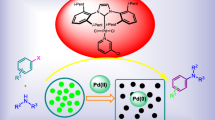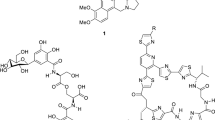Abstract
The design of new redox-switchable molecules requires the development of simple and efficient synthetic approaches. This study demonstrates the possibility of ortho-lithiation of ferrocenecarboxaldehyde (aryl)imines (Ia–Ic) followed by the reaction with ketones to give 1,2-disubstituted ferrocenes (IIa–IIc). These products, in turn, can be cyclized by treatment with trimethylsilyl triflate to give the cationic precursors of ferrocene-containing N-heterocyclic carbenes (IIIa–IIIc), in which the heterocycle is annulated to one of the ferrocene cyclopentadienyl ring. Treatment of IIIa–IIIc with a base in the presence of a source of rhodium afforded rhodium carbene complexes (IVa, IVb) in which the carbene ligand resembled cyclic alkylaminocarbenes in the electron-donor properties. Compounds Ib and IVa were studied by X-ray diffraction (CIF file CCDC nos. 2000413 and 2000414, respectively).


Similar content being viewed by others
REFERENCES
Canary, J.W., Chem. Soc. Rev., 2009, vol. 38, no. 3, p. 747.
Molecular and Supramolecular Information Processing: From Molecular Switches to Unconventional Computing, Katz, E., Ed., Weinheim Chichester: Wiley, 2012.
Sivaev, I., Molecules, 2017, vol. 22, no. 12, p. 2201.
Molecular Switches, Feringa, B.L. and Browne, W.R., Eds., Weinheim: Wiley-VCH, 2011.
Wang, X., Song, S., and Zhang, H., Chem. Soc. Rev., 2020, vol. 49, no. 3, p. 736.
Blanco, V., Leigh, D.A., and Marcos, V., Chem. Soc. Rev., 2015, vol. 44, no. 15, p. 5341.
Sims, C.M., Hanna, S.K., Heller, D.A., et al., Nanoscale, 2017, vol. 9, no. 40, p. 15226.
Al-Kutubi, H., Zafarani, H.R., Rassaei, L., and Mathwig, K., Eur. Polym. J., 2016, vol. 83, p. 478.
Wu, T.-H., Hsu, Y.-Y., and Lin, S.-Y., Small, 2012, vol. 8, no. 13, p. 2099.
Sarkar, S., Dutta, S., Chakrabarti, S., et al., ACS Appl. Mater. Interfaces, 2014, vol. 6, no. 9, p. 6308.
Nikovskiy, I., Polezhaev, A., Novikov, V., et al., Chem.-Eur. J., 2020, vol. 26, no. 25, p. 5629.
Pavlov, A.A., Aleshin, D.Y., Nikovskiy, I.A., et al., Eur. J. Inorg. Chem., 2019, vol. 2019, no. 23, p. 2819.
Gallei, M. and Rüttiger, C., Chem.-Eur. J., 2018, vol. 24, no. 40, p. 10006.
Wei, J. and Diaconescu, P.L., Acc. Chem. Res., 2019, vol. 52, no. 2, p. 415.
Hopkinson, M.N., Richter, C., Schedler, M., and Glorius, F., Nature, 2014, vol. 510, no. 7506, p. 485.
Bourissou, D., Guerret, O., Gabbaï, F.P., and Bertrand, G., Chem. Rev., 2000, vol. 100, no. 1, p. 39.
Jacobsen, H., Correa, A., Poater, A., et al., Coord. Chem. Rev., 2009, vol. 253, no. 5, p. 687.
Crudden, C.M. and Allen, D.P., Coord. Chem. Rev., 2004, vol. 248, no. 21, p. 2247.
Crabtree, R.H., Coord. Chem. Rev., 2013, vol. 257, no. 3, p. 755.
Huynh, H.V., Chem. Rev., 2018, vol. 118, no. 19, p. 9457.
Díez-González, S. and Nolan, S.P., Coord. Chem. Rev., 2007, vol. 251, no. 5, p. 874.
Gusev, D.G., Organometallics, 2009, vol. 28, no. 22, p. 6458.
Melaimi, M., Soleilhavoup, M., and Bertrand, G., Angew. Chem., Int. Ed. Engl., 2010, vol. 49, no. 47, p. 8810.
Lavallo, V., Canac, Y., Präsang, C., et al., Angew. Chem., Int. Ed. Engl., 2005, vol. 44, no. 35, p. 5705.
Nikovskiy, I.A., Spiridonov, K.A., Zakharova, D.V., et al., Inorg. Chim. Acta, 2019, vol. 495, p. 118976.
Polezhaev, A.V., Ezernitskaya, M.G., and Koridze, A.A., Inorg. Chim. Acta, 2019, vol. 496, p. 118844.
Koridze, A.A., Polezhaev, A.V., Safronov, S.V., et al., Organometallics, 2010, vol. 29, no. 19, p. 4360.
Polezhaev, A.V., Liss, C.J., Telser, J., et al., Chem.-Eur. J., 2018, vol. 24, no. 6, p. 1330.
Sheldrick, G., Acta Crystallogr., Sect. A: Found. Adv., 2015, vol. 71, no. 1, p. 3.
Dolomanov, O.V., Bourhis, L.J., Gildea, R.J., et al., J. Appl. Crystallogr., 2009, vol. 42, no. 2, p. 339.
Peris, E., Chem. Rev., 2018, vol. 118, no. 19, p. 9988.
Siemeling, U., Eur. J. Inorg. Chem., 2012, vol. 2012, no. 22, p. 3523.
Takagaki, W., Yasue, R., and Yoshida, K., Bull. Chem. Soc. Jpn., 2020, vol. 93, no. 2, p. 200.
Yoshida, K. and Yasue, R., Chemistry, 2018, vol. 24, no. 70, p. 18575.
Rao, B., Tang, H., Zeng, X., et al., Angew. Chem., Int. Ed. Engl., 2015, vol. 54, no. 49, p. 14915.
Alvarez, S., Chem. Rev., 2015, vol. 115, no. 24, p. 13447.
ACKNOWLEDGMENTS
X-ray diffraction studies were supported by the Ministry of Science and Higher Education of the Russian Federation and were performed using research equipment of the Center for Studies of Molecular Structure of the Nesmeyanov Institute of Organoelement Compounds, Russian Academy of Sciences.
Funding
This study was supported by the Russian Science Foundation (project no. 18-73-00208).
Author information
Authors and Affiliations
Corresponding author
Ethics declarations
The authors declare that they have no conflicts of interest.
Additional information
Translated by Z. Svitanko
Rights and permissions
About this article
Cite this article
Nikovskii, I.A., Spiridonov, K.A., Pavlov, A.A. et al. Synthetic Approaches to New Redox-Active Carbene Ligands. Russ J Coord Chem 47, 117–126 (2021). https://doi.org/10.1134/S1070328421020044
Received:
Revised:
Accepted:
Published:
Issue Date:
DOI: https://doi.org/10.1134/S1070328421020044




